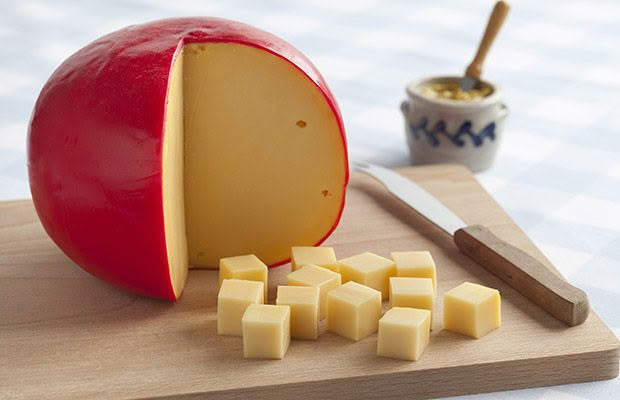How to make Edam cheese

Great Edam is lean, smooth and mellow, just how we’d all like to be.
An extract from How to Make Cheese & Other Dairy Products, Volume 1, by Jean Mansfield
Edam is a traditional Dutch cheese which is usually waxed for sale at six weeks old. The red cannon balls are common in photos of Holland. The black waxed cannon balls are matured for 17 weeks or more and have a more robust and intense taste, a very attractive addition to your cheeseboard. I developed this edam recipe when I was in one of my skinny phases. I was going on a cruise and decided that I did not look like the ‘beautiful people’ on the glossy brochures and lost 10kg with the help of this low-fat cheese.
Makes 1kg
Prep time 2.5 hours
Pressing/Brine time 18 hours
INGREDIENTS
■ 10 litres milk (or blue top or full cream)
■ ½ tsp mesophilic culture
■ 0.7 ml liquid rennet*
■ Cool boiled water
■ Brine
METHOD
Warm milk in a bain-marie to 31°C over a few minutes. Add the mesophilic culture to the milk (I use Flora Danica) and stir gently for 30 seconds, then leave for 30 minutes to mature. Keep the temperature at 31°C by adding warm water to the outer pot of the bain-marie.
Dilute 0.7ml rennet in 10ml cooled boiled water and stir gently into the milk. Cover the milk and leave to set for 30 minutes, again maintaining the temperature at 31°C.
* Always check the strength of your rennet on its container and adjust the amount you use to suit the amount of milk in the recipe. See page 9 for more information if you’re unsure.
Use a long-bladed knife to cut cleanly across the middle of the curd to the bottom of the pot to check for set. If the cut separates cleanly showing lemon-coloured clear whey then the curd is ready to cut. If it doesn’t cut cleanly, leave for a further five minutes and check the temperature as cool curds take longer to set. Once it tests cleanly, take off the element and cut into 1.25cm cubes, then stand for five minutes.
Heat the cut curd slowly to 33°C (this is only a 2°C degree difference) over 15 minutes – slowly add warm water to the outer pot of the bain-marie. Do not heat too quickly, and stir occasionally to prevent the curds from clumping together. Once at 33°C, let curds settle for 10 minutes.
Drain off whey so it is just covering the curds (reserve this whey in a sanitised jug), then replace it with the same quantity of warm water. Wash the curds through by stirring gently for 30 seconds while maintaining 33°C temperature. Stop stirring, then let curds settle and begin to mat together for five minutes.
Line a Kadova mould with cheesecloth. Pour half your reserved whey into a pot and the rest through the mould to warm it up. Ladle in the curd, pull the cloth up the sides and over the top, put the follower on top, then press with a 7kg weight for 30 minutes.
Heat the reserved whey to 50°C, then remove from heat. Remove cheese from mould, unwrap and place in container of hot whey so it is just covered) for 20 minutes to harden the outside of the cheese.
Remove cheese from whey, reline with the same cheesecloth and place back in mould. Press at 18kg for six hours.
Remove cheese from mould, unwrap and place in a brine solution (1 cup of salt to four cups of water) so it is just covered and store in a cool place (10-12°C) for 12 hours, turning once.
Remove from brine and place on a draining mat in a cool place (below 20°C) for two days, turning daily.
This cheese may be aged naturally in an airtight plastic container at a temperature between 10-12°C for two months. Wash the cheese daily with a brine-soaked cloth, or wax when fairly dry to the touch and keep at 10-12°C for two months
Jean’s tips
■ Edam gets its unique rounded edges thanks to the Kadova mould. If you don’t have a Kadova mould use a tomme mould instead. This has a flat bottom. Or use a pipe mould placed on a draining mat and use a follower to press the curds.
■ If you like a strong-tasting edam, leave it to age for at least six months.

